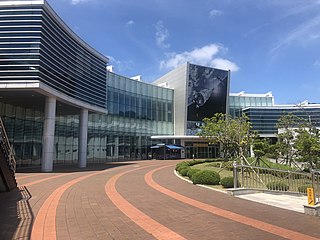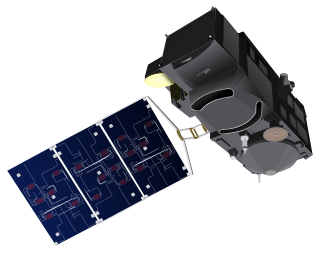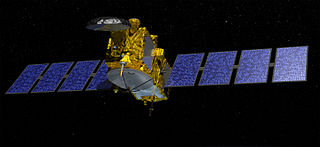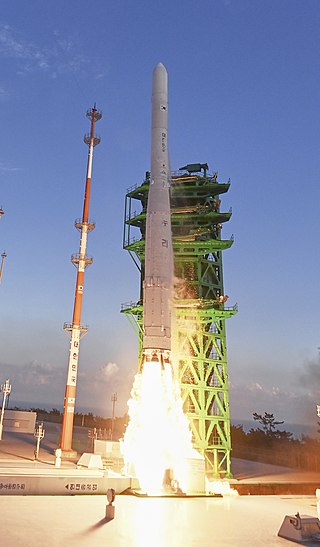
Chang'e 1 was an uncrewed Chinese lunar-orbiting spacecraft, part of the first phase of the Chinese Lunar Exploration Program. The spacecraft was named after the Chinese Moon goddess, Chang'e.

European Remote Sensing satellite (ERS) was the European Space Agency's first Earth-observing satellite programme using a polar orbit. It consisted of two satellites, ERS-1 and ERS-2, with ERS-1 being launched in 1991.

TOPEX/Poseidon was a joint satellite altimeter mission between NASA, the U.S. space agency; and CNES, the French space agency, to map ocean surface topography. Launched on August 10, 1992, it was the first major oceanographic research satellite. TOPEX/Poseidon helped revolutionize oceanography by providing data previously impossible to obtain. Oceanographer Walter Munk described TOPEX/Poseidon as "the most successful ocean experiment of all time." A malfunction ended normal satellite operations in January 2006.

The Meteor spacecraft are weather observation satellites launched by the Soviet Union and Russia. The Meteor satellite series was initially developed during the 1960s. The Meteor satellites were designed to monitor atmospheric and sea-surface temperatures, humidity, radiation, sea ice conditions, snow-cover, and clouds. Between 1964 and 1969, a total of eleven Soviet Union Meteor satellites were launched.

The Korea Aerospace Research Institute, established in 1989, is the aeronautics and space agency of South Korea. Its main laboratories are located in Daejeon, in the Daedeok Science Town. KARI's vision is to continue building upon indigenous launch capabilities, strengthen national safety and public service, industrialize satellite information and applications technology, explore the Moon, and develop environmentally-friendly and highly-efficient cutting-edge aircraft and core aerospace technology. Current projects include the KSLV-2 launcher. Past projects include the 1999 Arirang-1 satellite. The agency was founded in 1989. Prior to South Korea's entry into the Institute for Advanced Engineering (IAE) in 1992, it focused primarily on aerospace technology.

Naro-1, previously designated the Korea Space Launch Vehicle or KSLV, was South Korea's first carrier rocket, and the first South Korean launch vehicle to achieve Earth orbit. On January 30, 2013, the third Naro-1 vehicle built successfully placed STSAT-2C into low Earth orbit.

The Naro Space Center is a South Korean spaceport in South Jeolla's Goheung County, operated by the state-run Korea Aerospace Research Institute.

The STARSHINE series of three artificial satellites were student participatory missions sponsored by the United States Naval Research Laboratory.

OSTM/Jason-2, or Ocean Surface Topography Mission/Jason-2 satellite, was an international Earth observation satellite altimeter joint mission for sea surface height measurements between NASA and CNES. It was the third satellite in a series started in 1992 by the NASA/CNES TOPEX/Poseidon mission and continued by the NASA/CNES Jason-1 mission launched in 2001.
KOMPSAT-2, also known as Arirang-2, is a South Korean multipurpose Earth observation satellite. It was launched from Plesetsk Cosmodrome, Russia at 07:45:43 UTC on 28 July 2006. It began to transmit signals at 14:00 UTC the same day. Like the earlier KOMPSAT-1 satellite, it takes its name from the popular Korean folk song Arirang. Its launch was the culmination of a project begun in 1995.

Sentinel-3 is an Earth observation heavy satellite series developed by the European Space Agency as part of the Copernicus Programme. It currently consists of 2 satellites: Sentinel-3A and Sentinel-3B. After initial commissioning, each satellite was handed over to EUMETSAT for the routine operations phase of the mission. Two recurrent satellites— Sentinel-3C and Sentinel-3D— will follow in approximately 2025 and 2028 respectively to ensure continuity of the Sentinel-3 mission.

Jason-3 is a satellite altimeter created by a partnership of the European Organisation for the Exploitation of Meteorological Satellites (EUMETSAT) and National Aeronautic and Space Administration (NASA), and is an international cooperative mission in which National Oceanic and Atmospheric Administration (NOAA) is partnering with the Centre National d'Études Spatiales. The satellite's mission is to supply data for scientific, commercial, and practical applications to sea level rise, sea surface temperature, ocean temperature circulation, and climate change.

SARAL is a cooperative altimetry technology mission of Indian Space Research Organisation (ISRO) and Centre National d'Études Spatiales (CNES). SARAL performs altimetric measurements designed to study ocean circulation and sea surface elevation.
STSat-2B, or Science and Technology Satellite-2B, was a South Korean satellite which was lost in the failure of the second flight of the Naro-1 launch vehicle. It was to have been operated by the Korea Aerospace Research Institute (KARI), and was intended to demonstrate technology for future spacecraft. The satellite had a mass of 100 kg (220 lb), and was expected to operate for at least two years.

Nuri, also known as KSLV-II, is a three-stage launch vehicle, the second one developed by South Korea and the successor to Naro-1 (KSLV-1). Nuri is developed by Korea Aerospace Research Institute (KARI). All three stages use indigenously developed launch vehicle engines, making Nuri the first indigenously developed South Korean orbital launch vehicle.

STSat-2C, or Science and Technology Satellite-2C, or Naro Science Satellite (ko:나로과학위성) was a South Korean satellite which was launched in 2013. It was operated by the Korea Aerospace Research Institute (KARI), and was intended to demonstrate technology for future spacecraft. The satellite had a mass of 100 kg (220 lb), and was expected to operate for less than a year.
Seung Jo Kim is a South Korean aerospace engineer. He has been the current President of Korea Aerospace Research Institute (KARI) since June 2011, where the most of the national aerospace systems like aircraft, satellites and rockets are developed. During his tenure, Kim led the development of smart Unmanned aerial vehicle (UAV), the launch of KOMPSAT-3, KOMPSAT-5, STSat-3 and the first Korean space launch vehicle, Naro-1. Before becoming president of KARI, Kim had been a professor of the Engineering College at Seoul National University since 1986. He chaired the KSAS in 2009, the KSCM from 2005 to 2006, and the KSIAM from 2004 to 2008. He was also head of the New Aerospace Technology Research Institute from 2001 to 2003. Kim has been a fellow of the American Institute of Aeronautics and Astronautics (AIAA) since 2010 and the Institute of Physics since 2004.

Meteor-3M No.1 was the first and only of the Meteor-3M series polar-orbiting weather satellites. It was launched on 10 December 2001 at 17:18:57 UTC from the Baikonur Cosmodrome in Kazakhstan. The satellite is in a Sun-synchronous orbit with an ascending node time of about 9AM.
MoonLIGHT is a laser retroreflector developed as a collaboration primarily between the University of Maryland in the United States, and the Italian National Institute for Nuclear Physics - National Laboratories of Frascati (INFN-LNF) to complement and expand on the Lunar Laser Ranging experiment started with the Apollo Program in 1969. MoonLIGHT was planned to be launched in July 2020 as a secondary payload on the MX-1E lunar lander built by the private company Moon Express. However, as of February 2020, the launch of the MX-1E has been canceled. In 2018 INFN proposed to the European Space Agency (ESA) the MoonLIGHT Pointing Actuators (MPAc) project and was contracted by ESA to deliver it. MPAc is an INFN development for ESA, with auxiliary support by the Italian Space Agency (ASI) for prototyping work. In 2021, ESA agreed with NASA to launch MPAc with a Commercial Lunar Payload Services (CLPS) mission. Nova-C, the lander on which MPAc will be integrated, is designed by Intuitive Machines and the landing site is Reiner Gamma. The expected launch date of the Nova-C mission carrying the instrument, IM-3, is in 2025.
Starlette and Stella are nearly identical French geodetic and geophysical satellites. Starlette was launched on 6 February 1975 and Stella on 26 September 1993. Starlette was the first passive laser satellite developed.















